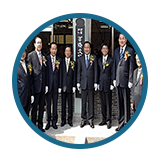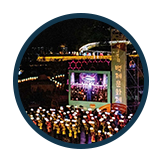About the festival
Origin of Baekje Cultural Heritage
Historical and cultural festival held annually since 1955.
-
1955
It originated from the fact that the nobles of the Buyeo region came together to form the ‘Baekje Grand Festival Executive Committee’ and held the ‘Baekje Grand Festival.’
-
1957
The name was changed to ‘Baekje Cultural Festival’ from the 11th time.
-
1960’s
Change from a ritualistic nature to a comprehensive cultural festival
-
2007
Establishment of Baekje Cultural Festival Promotion Committee (currently Baekje Cultural Festival Foundation)
-
1966
Gongju-gun (currently Gongju-si) participates in the Baekje Cultural Festival
-
1965
The scale of the event was expanded after being transferred to Chungcheongnam-do
-
2010
The 2010 World Grand Baekje Exhibition was held to become a global historical and cultural festival
-
2023
A new leap forward for Baekje culture, aided by the Korean Wave, with the successful hosting of the 2023 Daebaekje Festival!
History of Baekje Cultural Heritage
Introduction stage (1955~1965) Held exclusively in Buyeo
From the 1st event in 1955 to the 11th event in 1965, it was held exclusively in Buyeo-gun. Looking at the main events of the time, the center was the ancestral rites for the three loyal gods of Baekje and the ancestral rites for the three thousand court ladies (Suryukjae), and in addition to the ancestral rite events, folklore, art, and sports competitions were added.
As folk games, competitions such as Nongak, Chucheon (swing), archery, and wrestling were held, and cultural and artistic events included a sijo competition, Baekil contest, Baekje princess selection contest, and a costume procession, a ritual to honor Baekje's vengeful soul. Except for this, it was a simple local event with the characteristics of a comprehensive culture and arts festival rather than a Baekje cultural festival.
At first, it was purely led by the private sector, but later on, as the number of event items increased each year and the public's attention focused, it gradually transformed into an event led by administrative agencies. This was to promote the development of the Baekje Cultural Festival by increasing the precision of the event and smoothly supporting the necessary budget and manpower.
In particular, the 11th Baekje Cultural Festival in 1965, which was first held under the name of the 'Baekje Cultural Festival', was held for three days from October 8, 1965, focusing on rituals (Samchungje, Gungnyeoje, Eunsan Byeolsingut) and folk games (archery, nongak). , wrestling, floating lantern boat, swing), cultural and sports events (sports competition, essay contest, sijo contest, general art presentation) and other events (Baekje princess selection contest, costume parade, lantern parade) were held, and President Park Chung-hee attended the opening ceremony. This raised the status of the festival.
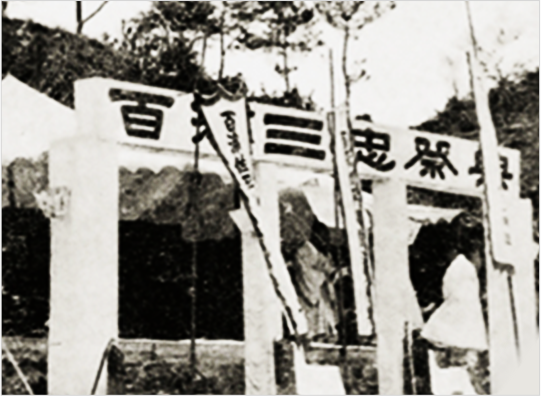
Settlement stage (1966~1978) Simultaneously held in Gongju and Buyeo
Since 1966, the Gongju region has also participated in the Baekje Cultural Festival, which was held simultaneously with Buyeo. The Gongju Baekje Cultural Festival began with an opening ceremony, ‘Memorial Service for the 5th King of Baekje Regeneration’ (Memorial Service for the 4th King of Baekje Regeneration since 1971), ‘Sabi Seongcheondo Torch Relay Ceremony’, and a lantern lighting ceremony. During this period, the Baekje Cultural Festival's ancillary cultural events began to noticeably increase. In particular, in the case of the Gongju area, the number of events expanded from only about 10 to over 40 in the late 1971s.
This is due to the fact that after 1973, as measures to revitalize the Baekje Cultural Festival were established, the ‘Baekje Cultural Festival Promotion Committee’ was established as an ordinance and large subsidies were provided to the province and county, making it institutionalized to support more than 80% of the budget from local funds. However, the Baekje Cultural Festival events held simultaneously in Buyeo and Gongju had many similar or overlapping characteristics, and it was burdensome for Buyeo and Gongju to prepare for the event each year.
Meanwhile, for four years from the 21st (1975), the Baekje Cultural Festival was expanded to include Daejeon in addition to Gongju and Buyeo.
This was intended to heighten the enthusiasm for the Baekje Cultural Festival throughout the entire province of South Chungcheong Province under the pretext of a grand festival in South Chungcheong Province. However, criticism was raised that the Baekje Cultural Festival in Daejeon, which lacked the historicity and symbolism of Baekje, was conducted as an exhibition-oriented event. Accordingly, the Daejeon hosting format was discontinued at the 24th event (1978).

Development stage (1979~2006) Gongju and Buyeo held every two years
Starting with the 25th Baekje Cultural Festival in 1979, it was held in Gongju and the following year, it was adjusted to a rotation system held in Buyeo. In other words, it was decided to hold the event alternately in Gongju in odd-numbered years and in Buyeo in even-numbered years, with the concept of large rites and small rites. The implementation of the biennial system is intended to secure more preparation time and improve the level of the event quantitatively and qualitatively. Since the 1980s, there have been about 40 types of events in Buyeo and 71 to 100 types in Gongju. It has expanded significantly.
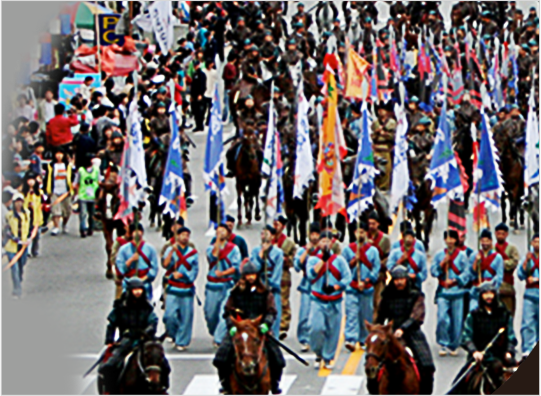
Globalization stage (2007~) Integrated Gongju and Buyeo holding
Although the Baekje Cultural Festival possesses excellent cultural resources, it has been evaluated as stagnant and unable to develop due to a lack of systematic development measures.
Accordingly, in the 4th popular election, the Baekje Cultural Festival was held every other year in Gongju-si and Buyeo-gun in order to foster it as a world-class festival and make it a core axis of balanced development in the southwestern region. The Baekje Cultural Festival was held in an integrated manner. If the ‘simultaneous hosting of Gongju and Buyeo’ (1966~1978) meant that the two regions each held the Baekje Cultural Festival without unity, then the ‘integrated hosting’ (2007~) was held in two regions. It means holding it simultaneously with unity. The Baekje Cultural Festival Promotion Committee (currently the Baekje Cultural Festival Foundation) was established as the organization responsible for the ‘integrated hosting.’ As a result, the Baekje Cultural Festival changed from a government-led festival to a private-led festival, revitalizing the cultural festival through the voluntary participation of residents and laying the foundation for becoming a world-class historical and cultural festival. The Baekje Cultural Festival has entered a new stage of development.
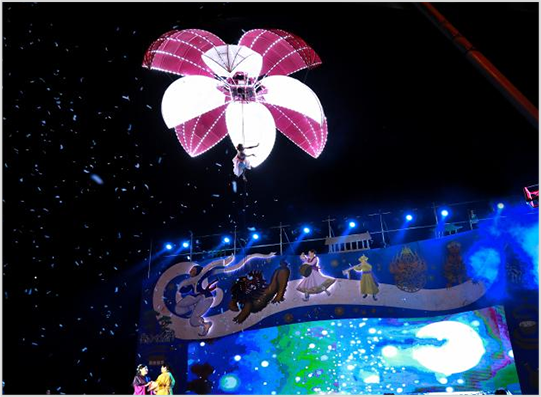
Beyond the festival, it contributes to spreading understanding and pride in the history and culture of Baekje.
The most noticeable change is the expansion of the festival budget. It increased to KRW 5.2 billion in 2007, KRW 9 billion in 2008, and KRW 31.8 billion for the 2010 World Grand Baekje Exhibition, making it possible to produce and direct specialized large-scale programs.
The period also increased from 5 days at the time of the 53rd Baekje Cultural Festival to 9-10 days after the 54th Baekje Cultural Festival. As the program was specialized based on the history and culture of Baekje and a variety of highly specialized programs became possible, the Baekje Cultural Festival was able to move beyond a local festival and pursue an internationalization and globalization strategy.
2009 With one month left until the 55th Baekje Cultural Festival (Predae Baekje Exhibition) due to the spread of the new flu, large-scale events were inevitably canceled except for the ritual events held by Gongju City and Buyeo County. However, based on the know-how accumulated after the 53rd Baekje Cultural Festival, the 2010 World Grand Baekje Exhibition was successfully held.
The '2010 World Great Baekje Exhibition', which was held as a government-sanctioned international event for 30 days from September 18 to October 17, 2010, attracted 3.69 million visitors and achieved an economic ripple effect of 249.9 billion won across the country. It was selected as one of the most successful festivals in the world.
The 57th Baekje Cultural Festival in 2011 was evaluated as having once again confirmed the possibility of becoming a world-class luxury festival, with 1.49 million visitors and an economic impact of 92 billion won.
In commemoration of the 1,400th anniversary of Mimaji, a Baekje person, transmitting Baekje instrumental music to Japan, the event will be held under the subtitle, 'Dance and Music of Baekje - The Revival of Mimaji (味摩之)' At the 58th Baekje Cultural Festival in 2012, a 'Mimaji Textbook Promotion Committee' was formed, which resulted in the inclusion of Mimaji-related content in high school textbooks.
The 59th Baekje Cultural Festival in 2013 was held with the subtitle 'The World of Gilt-bronze Incense Burner' to commemorate the 20th anniversary of the excavation of Baekje Gilt-bronze Incense Burner (National Treasure No. 287), and 1.6 million visitors visited. , achieved an economic ripple effect of 108 billion won.
The 60th Baekje Cultural Festival in 2014 was held as an international event to commemorate the year of Gap (甲年), and was held from September 26 to October 5 with the event ‘Baekje! 106 programs were conducted under the theme of ‘Meet the World – Ryu (流), Excitement, and Fashion’, serving as an opportunity to promote Korea's representative historical and cultural festival both domestically and internationally.
On July 8, 2015, the Baekje Cultural Festival reached a new turning point as the Baekje Historic Site was registered as Korea's 12th World Heritage Site. The Baekje Cultural Festival has transformed into a festival that widely recognizes the excellence of Baekje historical sites and Baekje culture at home and abroad.
The 61st Baekje Cultural Festival was titled ‘Baekje is reborn’, and the 62nd Baekje Cultural Festival was titled ‘Baekje! The 63rd Baekje Cultural Festival was held under the themes of ‘Embrace the World’ and ‘Meet Baekje, the Originator of the Korean Wave’. In addition, the 64th Baekje Cultural Festival was held with themes and subtitles such as ‘Enjoying Baekje, the origin of the Korean Wave – Baekje’s dances and songs’ and the 65th Baekje Cultural Festival ‘Enjoying Baekje, the origin of the Korean Wave – Baekje’s food, clothing and shelter’. The purpose is to highlight Baekje as the ‘cultural powerhouse of ancient East Asia’ by highlighting from various angles through the Baekje Cultural Festival that it was the ‘originator of the Korean Wave’.
Beyond the festival, the Baekje Cultural Festival contributes greatly to spreading understanding and pride in the proud history and culture of Baekje, and is emerging as a specialized cultural resource.




